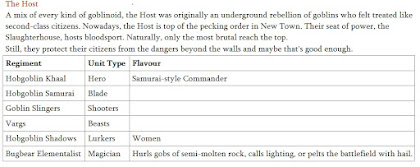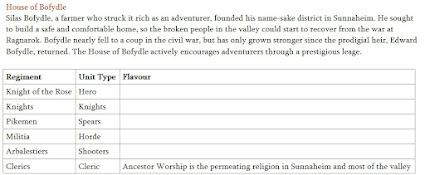The one with rules-writing for the HOTT-campaign in the city of Sunnaheim, Valley of the Tarrasque.
I have mentioned in a previous post that a campaign using HOTT would be alot of fun to use as a worldbuilding-tool for the homebrew rpg-world known as The Valley of the Tarrasque. As we have slowly been getting into Tabletop Simulator and HOTT as a rules-system the past week, I have decided to start fleshing out the campaign-rules while Jonas focuses on the worldbuilding itself.
HOTT as a game, with it's mechanics, is more suited to portray the commandfriction in huge armies where an element might represent 1000 individuals rather than a more modest force in the 50s-100s. I have decided to do some mental gymastics and disregard from that fact and use the rules anyway since:
A) They are fun!
B) See above.
Yeah, that's pretty much the argument I have. :)
There is nothing groundbreaking when it comes to the setup of the campaign-rules as I have mixed and matched existing rules from various sources together with my own thoughts, with Kaptain Kobold being a major influence.
On my to-do-list remains any feedback on the campaignrules and to digitally build the armies in Tabletop Simulator. An issue on the horizon is that we statistically are looking down the barrel of 36 tabletop battles in the campaign..... Maybe change it to fewer turns?
On Jonas' plate are the minor factions, with names and lore, together with suggestions for trooptypes that I will try to balance somewhat into armies.
...and probably more stuff as it comes up.
We need a cool campaign map I guess, especially if we are gonna compile everything into some kinda of narrative AAR either in blog- or video-format down the line.
Anyway, on to the rules. I do apologize for the WOT.
Be adviced that anything from here on out is subject to change.
War in The Valley of the Tarrasque:
Sunnaheim was in a state of upheaval some years ago and 3 major powerblocks emerged as potential rulers for the various important parts of the city and it's surroundings. During a period of 2 years they wrestled for as much control as possible in the city-state, both amongst themselves aswell as against smaller factions in the area. The scale of the conflict was not only one of streetgangs and knives in the darkness, but also one where armies were amassed to meet each other in pitched battle.
The outcome of the campaign will be a part of the worldbuilding for the Valley of the Tarrasque and is meant to flesh out the factions that are ruling over the city as of now. Ie. the more 'City Influence'-points the major faction gains in the campaign, aswell as any minor factions they have subdued, the bigger their sphere of influcence is in the city today.
One thing of note is that the battles in the campaign is not just about the districts in the city, but are also against neighbouring clans, tribes and merchant empires to get control of potential allies and traderoutes in the Valley.
point in the timeline. The list during the campaign is still to be determined.
The Basics.
All battles will be fought using HOTT 2nd Edition, with the FAQ and optional terrain placement rules by Kaptain Kobold. (Links below)
Major factions.
These are The Host, The Blacksmiths and the Bofylde Family.
Major factions start the campaign at 0 City Influence, with the goal of gaining as much City Influence as possible during the 2 years (24 turns) the campaign lasts.
The OOB for a major factor is determined before the campaign starts and can consist of 36AP total, of which 6 must be a Hero. Sidenote: If a Hero is not selected (for any reason, including being in reserve/dead) in the 'Preparing as battle' paragraph below, a horse-mounted or infantry element needs to be appointed to act as the C-in-C for the corresponding rule-purposes as outlined in HOTT.
Minor factions.
The minor factions represents the smaller players such as guilds, nobility and tribes in the area around Sunnaheim. No matter the outcome in the war, they will all eventually succumb in turn to the major factions in the aftermath of the powerstruggle the campaign revolves around.
The minor factions will always have the troops listed on their respective army-list for battles they are involved in. They do not roll for destroyed elements to see what happens with them.
A minor faction can only withstand 2 losses thru combat after which it's considered to have yielded under the banner of a major faction. After their first loss, the faction beating them gets 1 City Influence. After their second loss, the faction beating them gets 2 City Influence and is eligble the rules in the 'Preparing as battle' paragraph below. Note: It only matters who "deals the final blow" towards a minor faction.
The campaign turn.
The campaign lasts for 2 years, with a turn for each major faction per month.
Each month roll a D6 per major faction, start with the one that has lowest accumulateed City Influence and go clockwise on the campaign-map. Note: If a major faction gets dragged into an event (4,5,6) before their roll comes up, it will count as their roll for the turn. They do not roll for themselves this month. They can however be eligble for another fight due to the random rolls from other major factions (Ie. the first two factions to roll both get to attack the third.)
1: Nothing new to report Milord.
Uneventful month where your troops rest and you consolidate your territory. Move one element of your choosing from your reserve to your OOB. If you do not have any elements in reserve add a Horde to your OOB, even if it exceeds 36AP. These represent the rabble in the city rallying to your cause.
2: Pestilence strikes!
Be it by magical trickery, the poisoning of your wells or just sheer bad luck, your army succumbs to a disease and hundreds of soldiers spend their time in the sickbed. Move a random element from your OOB to reserves.
3: To rule with an Iron Fist.
Your forces snuffs out a few minor raids, or maybe your political scheming finally bears fruit. By complete accident it even might be that a high-ranking official of an enemy happens to get a completely unthinkable heart-attack while visiting the local bathhouse. Gain 1 City Influence.
4: Sound the Alarm!
You are attacked and have to roll a D6.
1-5: A random minor faction attacks you.
6: The faction with most City Influence has deemed you ripe for a harvest and attack you.
You are the defender.
5: A scout returns.
While on a patrol, your scouts happen upon a weak enemy army and a fight ensues. Roll a D6.
1-5: It's a force from a random minor faction.
6: It's the major faction with the least City Influence.
You are the attacker.
6: Fortune favors the bold!
Your oracles has recieved a vision from the gods with a call for holy war or your populace are itching for a fight and must be pitted against an enemy lest infigthing and riots in your territory erupts. It might even be that your glorious and infinite wisdom has granted you the foresight to lure a weak enemy onto the battlefield.
Choose an opponent (major or minor) to goad into battle and decide if you want to be the defender or the attacker.
Preparing a battle:
Major factions always choose their armylist before the battle from their OOB, 24 AP maximum. If they have fewer points than this, they may yield the battlefield to the enemy and preserve their troops for another day or fight with at a severe disadvantage. Yielding the field will be seen as a cowardly and impotent move by civilians and soldiers alike, which causes the yielding faction to loose 2 City Influence. (Note: The "winner" still only gains 1 City Influence.)
If the major faction previouisly has subdued a minor faction in the campaign, roll a D6 before assembling the armylist.
1-4: No troops available.
5-6: You have the choise to pressgang your underling to fight for you. You may choose up to two elements from that minors armylist and add them to your army, for this battle only. The elements must be the most common troop-type in their list.You pay for them as normal with your AP, essentially having them replace your own troops. Better to have the uncouth masses acting as a meatshield than our own solders, amrite Milord?
Minor factions always use their predetermined armylist of 24 AP.
After a battle:
The winning side in a battle between two major factions gains 1 City Influence, while the defeated party looses 1 City Influence. This applies regardeless of who was the attacker of defender in the battle.
(Note: See 'yield the battlefield' above.)
Winning a battle against a minor faction nets you 1 City Influence. If the battle casues the minor faction to be subdued, you instead get 2 City Influence. If you loose the battle, you also loose 1 City Influence.
Every element that has been destroyed in the battle has to roll a D6.
1: The element is permanently out of action, depleted of soldiers that have fled from the VotT or get merged into other units. Remove it from your OOB for the reminder of the campaign.
2: The element needs to be replenished and the survivors have to heal up. Move the element from the OOB to the reserves.
3-6: The element is returned to the OOB with no adverse effect.
HOTT FAQ: http://hordesofthethings.blogspot.com/p/hott-faq.html
Terrain placement: http://hordesofthethings.blogspot.com/2012/04/random-terrain-for-hott.html
Kaptain Kobold @ http://hordesofthethings.blogspot.com/
Cheers for sticking with me thru the rules. Please comment with any glaring issue you find in them.
/Fred
Back to The Factorium!




Comments
Post a Comment